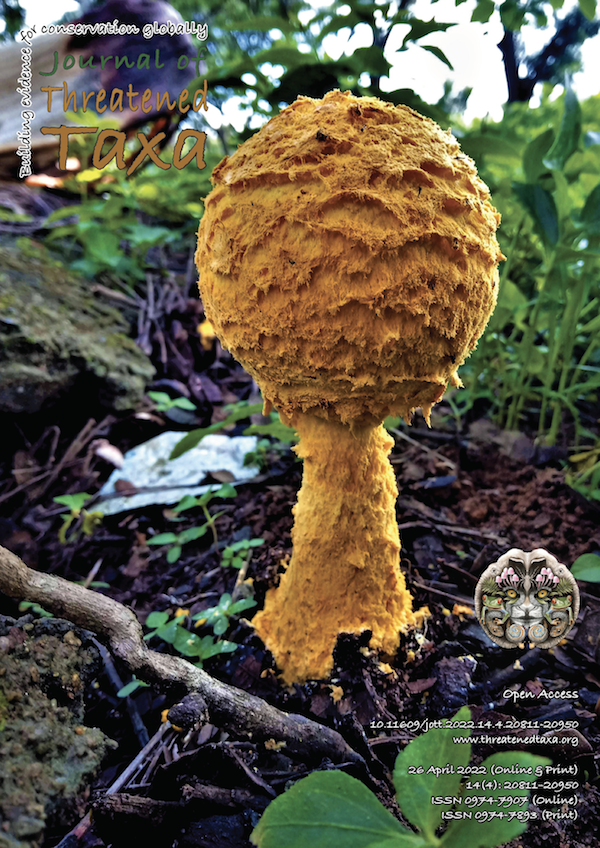Distribution of the genus Pinguicula (L., 1753) (Lentibulariaceae) in Gunma Prefecture, Japan with new records
Main Article Content
Abstract
We studied the distribution of two Pinguicula (Butterwort) species in Gunma Prefecture, Japan based on our herbarium specimen examinations and field observations. As a result, several localities of Pinguicula macroceras, such as Mt. Akagi-yama or the Tanigawa Mountain Range, were present today. In addition, two new localities of P. macroceras, Mts. Hotaka-yama and Ojikazawa-no-kashira, which had not been previously recorded, were found. However, only a single locality of P. ramosa, a threatened species (Endangered in the Red List of Gunma Prefecture and Vulnerable in the Red List of the Ministry of the Environment of Japan), was confirmed to be present in the prefecture. The two species have extremely narrow environmental preference and are restricted to specific environmental niches. The population size of both species at each microhabitat is small and there is a potential risk of disappearance of those localities in the future by the impacts of environmental stress or human activities. This study documents the current situations of the genus in Gunma Prefecture and suggests that urgent conservation is necessary to protect both the two species and their habitats in the prefecture.
Article Details

This work is licensed under a Creative Commons Attribution 4.0 International License.
Authors own the copyright to the articles published in JoTT. This is indicated explicitly in each publication. The authors grant permission to the publisher Wildlife Information Liaison Development (WILD) Society to publish the article in the Journal of Threatened Taxa. The authors recognize WILD as the original publisher, and to sell hard copies of the Journal and article to any buyer. JoTT is registered under the Creative Commons Attribution 4.0 International License (CC BY), which allows authors to retain copyright ownership. Under this license the authors allow anyone to download, cite, use the data, modify, reprint, copy and distribute provided the authors and source of publication are credited through appropriate citations (e.g., Son et al. (2016). Bats (Mammalia: Chiroptera) of the southeastern Truong Son Mountains, Quang Ngai Province, Vietnam. Journal of Threatened Taxa 8(7): 8953–8969. https://doi.org/10.11609/jott.2785.8.7.8953-8969). Users of the data do not require specific permission from the authors or the publisher.
References
Botanical Society of Japan (1888). Notes: Botanical field expedition to the Shikoku region. Botanical Magazine, Tokyo 2: 202–204.
Casper, S.J. (1962). On Pinguicula macroceras Link in North America. Rhodora 64: 212–221.
Casper, S.J. (1966). Monographie der gattung Pinguicula L. Bibliotheca Botanica. 127/128.
Casper, S.J. and R. Stimper (2009). Chromosome numbers in Pinguicula (Lentibulariaceae): survey atlas, and taxonomic conclusions. Plant Systematics and Evolution 277: 21–60.
Domínguez, Y., C.M.P. Valdés & V.F.O. Miranda (2017). Typification of name in the genus Pinguicula L. (Lentibulariaceae). Phytotaxa 312: 179–198.
Fleischmann, A. & A. Roccia (2018). Systematics and evolution of Lentibulariaceae: I. Pinguicula. pp. 70–80. In: Ellison A.M. & L. Adamec (eds.), Carnivorous Plants: Physiology, Ecology, and Evolution. Oxford University Press. Oxford.
Gunma Prefecture (2018). Red List, Plants. revised in 2012 and partially revised in 2018. https://www.pref.gunma.jp/contents/100071278.pdf. Downloaded on 01 December 2020.
Hattori, T. (1908). The Carnivorous Plants. Ogawashoeido, Tokyo, 252pp.
Hattori, T. (1909). Carnivorous Plants of Japan. Rokumeikan, Tokyo, 109pp.
Katagiri, Y. (1980). Pinguicula vulgaris L. var. macroceras Herder, pp. 119–121. In: Ishizawa S. (ed.), Distribution Maps of Plants of Niigata Prefecture, Vol. 1. No. 35. Niigata Jinenjyo-kai, Ojiya.
Kawase, D. & T. Yumoto (2006). Clonal structure and genetic differentiation in the serpentine plant Japonolirion osense (Petrosaviaceae) using AFLP markers. Acta Phytotaxonomica et Geobotanica 57: 183–190.
Kawase, D., T. Yumoto & K. Sato (2009). Phylogeography of a rare serpentine plant, Arenaria katoana Makino (Caryophyllaceae). Acta Phytotaxonomica et Geobotanica 60: 19–25.
Kobayashi, K. & E. Nakamura (2001). Geochemical Evolution of Akagi Volcano, NE Japan: Implications for interaction between island-arc magma and lower crust, and generation of isotopically various magmas. Journal of Petrology 42: 2303–2331. https://doi.org/10.1093/petrology/42.12.2303
Komiya, S. & C. Shibata (1998). Japanese Pinguicula (Lentibulariaceae). Bulletin of Nippon Dental University, General Education 28: 117–146.
Ministry of the Environment (2020). Red List 2020. http://www.env.go.jp/press/107905.html. Accessed on 28 December 2020.
Miyoshi, M. (1890). Notes on Pinguicula ramosa sp. nov. Botanical Magazine, Tokyo 4: 314–319.
Moriya, A. (1976). Plants of Tochigi, Shimotsuke-bunko 2, Gekkan-Satsuki-Kenkyusha, Kanuma.
Sasaki, A. & Y. Kariya (2000). Initiation age of a peaty soil layer in the subalpine zone of Mount Tairappyo, the Mikuni Mountains, Central Japan. Quarterly Journal of Geography 52: 283–294.
Shimai, H. (2016). Pinguicula ramosa Miyoshi–a botanical review. Carnivorous Plant Newsletter 45: 51–68. https://cpn.carnivorousplants.org/articles/CPNv45n2p51_68.pdf
Shimai H, H. Setoguchi, D.L. Roberts & M. Sun (2021). Biogeographical patterns and speciation of the genus Pinguicula (Lentibulariaceae) inferred by phylogenetic analyses. PLoS ONE 16: e0252581. https://doi.org/10.1371/journal.pone.0252581
Tamura, M. (1953). Key to the insectivorous plants of Japan. Acta Phytotaxonomica et Geobotanica 15: 31–32.
Tomimatsu, H., A. Hoya, H. Takahashi & M. Ohara (2004). Genetic diversity and multilocus genetic structure in the relictual endemic herb Japonolirion osense (Petrosaviaceae). Journal of Plant Research 117: 13–18. https://doi.org/10.1007/s10265-003-0121-7
Yamanaka, T. (1953). Pinguicula vulgaris var. macroceras Herd. newly found in Shikoku. Journal of Japanese Botany 28: 30–31. https://jjbotany.com/pdf/JJB_028_30_31.pdf
Zamudio, S. (2005). Lentibulariaceae. Flora del Bajío y de Regiones Adyacentes 136: 1–61.

